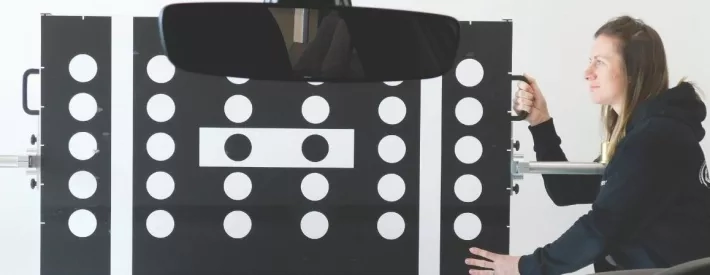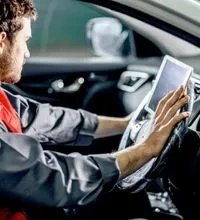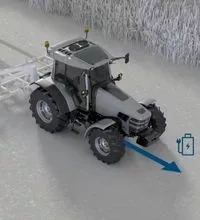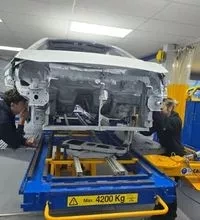Keeping ADAS systems aligned

Technology doesn’t stand still, there are constant shifts as automotive embraces new approaches to vehicles, mobility and driver interaction with systems.
Advanced driver assistance systems (ADAS) are a critical part of this journey, designed to make vehicles, roads and vulnerable road users safer, but also take some of the hassle out of driving.
With increasing numbers of vehicles integrating ADAS technology it’s becoming more important that workshops are prepared for when they roll into businesses, but also that front of house staff are switched on to what the various technologies are.
Defining ADAS technology
There can be some confusion about what ADAS systems are, and just because a vehicle has sensors onboard doesn’t necessarily mean it’s ADAS-equipped.
Principal Engineer of ADAS at Thatcham Research Yousif Al-Ani explains: “Our definition is a system that uses a sensor to detect some information, usually outside the vehicle, and then make a vehicle reaction based on that.
“Some technologies that aren't ADAS often get attributed incorrectly, like cruise control. [That’s] open loop, you just set it, and it does what you set it to. That's not using any sensing. It's not using closed loop feedback. So, it’s not ADAS.
“In terms of ADAS, it's the big seven: Autonomous Emergency Braking, Lane Keep Assist, Adaptive Cruise Control, Driver Monitoring, Intelligent Speed Assist, Blind Spot Information Systems and ‘Level 2’ assisted driving. These technologies either prevent or mitigate a collision or make the driving task easier somehow.”
Autonomous or not
There is some debate about the definitions attributed to ADAS-equipped vehicles. Many people will have heard of the SAE Levels of Driving Automation that breaks down the different stages of assisted and autonomous driving into five levels. The linguistic challenge is highlighting that while a vehicle maybe described as having Level 2 autonomy, it doesn’t mean it’s self-driving. On the SAE scale anything up to Level 2 is supported driving.
“Level 2 is assisted; the driver is always liable. Autonomy means the vehicle is liable, and that's been brought into law from last year,” says Al-Ani. It’s an important differentiation.
All seeing
Underneath the metal ADAS-equipped vehicles are home to a range of sensors that help the vehicle view the world around it, allowing it to complete tasks such as dynamic throttle control and braking.
“Ultrasonics are probably the longest-serving technology. Forward-facing cameras, radars all around the vehicle – forward facing radars do object detection for ACC or AEB, rear radars do blind spot, generally. Side radars might support door opening prevention for approaching cyclists. So, we're at a point where we've got 360º radar,” says Al-Ani.
“We're just starting to see LiDAR coming through, especially in the UK, but at very, very low volume. It's basically just a radar that uses a laser rather than microwaves. It's electronically scanning a grid of pixels with a laser. For each pixel, you get a power return. So, if the laser hits a car you get a really big reflection, and it comes out very hot on those pixels. If it detects trees or foliage, it comes back very cold with a low reflection. That generates an intensity map of an image over a grid, what you call a point cloud.”
LiDAR could become more important in the future as prices come down, legislation changes ¬– in the UK at least ¬– allowing its use for truly autonomous driving scenarios.
Repairability
With new technologies come new approaches to making sure vehicles are roadworthy and remain so.
For any vehicle with ADAS calibration is critical. A sensor or suite of sensors that aren’t set up properly won’t be able to read the road ahead correctly, giving false readings or simply not working at all. The issue is made more complicated by the age of the vehicles and the technology used.
“Anything pre-2020, we would call a legacy vehicle. These tend to require static alignment in the repair workshop, you can't align them by driving, and they don't support any automatic alignment,” says Al-Ani.
Aligning the car’s systems into a bad position will compromise performance and it doesn't have the capability to detect if it's misaligned, and there’s no warning light to inform the driver.
“Knowing when those systems need to be repaired is much more challenging. And there's a lot more advanced training that's needed, in addition to knowledge of sensors and systems. Manual checks may be required, perhaps putting inclinometers on sensors and really going quite deep into a physical diagnosis,” says Al-Ani.
Newer ADAS technologies are arguably easier and more robust: “Auto-alignment functions will self-calibrate. And if the repair's not been done correctly, if the structure is still bent and it's physically out of tolerance, you will get that warning light very quickly. All you have to do is undertake a drive cycle, and you will know what the fault is and how to resolve it.”
The future’s over-the-air
As technologies progress the ability and approach to repair and calibrate will change. In fact, it already is in some areas, driven by connectivity and the ability to update systems over the air.
“We're rapidly approaching the best-case scenario,” says Al-Ani. “Five years from now, the future might see these faults being detected by the vehicle, the repairer won’t even need to run the diagnostic. It can be done over-the-air by the manufacturer.”
Al-Ani says that it could be that an over-the-air health check is conducted, it’s found the vehicle has an ACC alignment issue for example, and it’s fixed using dynamic calibration. All run in the background, not visible to the driver or even to the repairer.
“OTA calibration is already happening. There are scenarios where a vehicle manufacturer and a windscreen replacement partner work together, so that when a windscreen is replaced, it's not the fitter that does the diagnostic, it's the vehicle manufacturer over-the-air,” says Al-Ani.
ADAS is the next step in automotive’s technology journey, and the number and types of sensors integrated into vehicles is only going to increase as we progress through the autonomous driving levels.
That could increase opportunities in the market for ADAS proficient Technician. As more systems come online and vehicles hit the road, legacy ADAS technologies will still require a more hands on approach, and that means more people with the skills to repair and calibrate the technologies.
Get ADAS-ready with the IMI’s range of courses, qualifications and accreditations.




